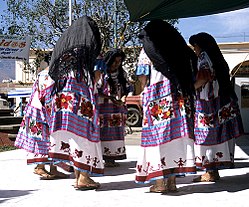Mazatec
 Mazatec girls performing a dance in Huautla de Jimenez | |
| Regions with significant populations | |
|---|---|
| Mexico (Oaxaca) | |
| Languages | |
| Mazatec, Spanish, | |
| Religion | |
| Roman Catholic, and Traditional religion | |
| Related ethnic groups | |
| Popolocas |
The Mazatec people are an indigenous people who inhabit an area known as the Sierra Mazateca in the state of Oaxaca in southern Mexico, as well as some communities in the adjacent states of Puebla and Veracruz. The meaning of "Mazatec" translates to "people of the deer," derived from the Nahuatl word Mazatl meaning deer.[citation needed]
Language family
The Mazatecan languages are part of the Popolocan family which, in turn, is part of the Otomanguean language family.
Post-colonial period
The Mazatecs' religion represents a syncretism of traditional beliefs with Christian beliefs brought by the Spanish conquistadores[citation needed].
Traditional religious rituals
Mazatec tradition includes the cultivation of entheogens for spiritual and ritualistic use. Plants and fungi used for this purpose include psilocybin mushrooms, psychoactive morning glory seeds (from species such as Ipomoea tricolor and Turbina corymbosa), and perhaps most significant to the Mazatecs, Salvia divinorum.[1][2] This latter plant is known to Mazatec shamans as ska María Pastora, the name containing a reference to the Virgin Mary.[3]
Notable Mazatecs
See also
Notes
- ^ Jean Basset Johnson (1939) The elements of Mazatec witchcraft, Etnologiska Studier 9:128-150.
- ^ Valdés et al. (1983)
- ^ Valdés et al. (1983)
References
- Campbell, Lyle (1997). American Indian Languages: The Historical Linguistics of Native America. Oxford Studies in Anthropological Linguistics, 4. William Bright (series general ed.) (OUP paperback edition, 2000 ed.). New York: Oxford University Press. ISBN 0-19-509427-1. OCLC 32923907.
- CDI [Comisión Nacional para el Desarrollo de los Pueblos Indígenas] (2004–2007). "Mazatecos - Ha shuta Enima". Información: Los pueblos indígenas de México (in Spanish). CDI. Archived from the original on 2007-06-09. Retrieved 2007-05-02.
- Karttunen, Frances E. (1994). Between Worlds: Interpreters, Guides, and Survivors. New Brunswick, NJ: Rutgers University Press. ISBN 0-8135-2030-4. OCLC 28150669.
- Mooney, James (1911). "Mazatec Indians". Catholic Encyclopedia. Vol. vol. X (New Advent online reproduction ed.). New York: Robert Appleton and Company. Retrieved 2007-05-02.
{{cite encyclopedia}}:|volume=has extra text (help) - Valdés, Leander J., III; José Luis Díaz; Ara G. Paul (1983). "Ethnopharmacology of ska María Pastora (Salvia divinorum, Epling and Játiva-M)". Journal of Ethnopharmacology. 7 (3): 287–312. doi:10.1016/0378-8741(83)90004-1. PMID 6876852. Retrieved 2006-12-20.
{{cite journal}}: CS1 maint: multiple names: authors list (link)
External links
